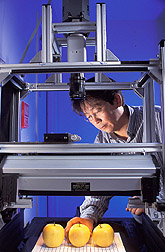This page has been archived and is being provided for reference purposes only. The page is no longer being updated, and therefore, links on the page may be invalid.
Detecting Possible E. coli Contamination on Fruit and ProduceBy Don ComisSeptember 30, 2002 The chance of fecal bacteria contaminating fresh produce or fruit juices could become nil when fruit- and produce-packing plants have a completely automated food safety inspection system installed in the near future. Yud-Ren Chen, an agricultural engineer with the Agricultural Research Service's Instrumentation and Sensing Laboratory in Beltsville, Md., is leading a group to develop "machine-vision" systems to detect contamination the human eye can't see. This would prevent Escherichia coli O157:H7 from tainting apple cider and juices made from apples and other fruits. This E. coli strain infects people who drink contaminated, unpasteurized cider or juices. Chen is starting with apples, but he expects the system to work with all fruits and produce. His on-line system would direct a camera to take three spectral images of each apple through different color filters. A computer would then analyze the spectral images to detect the telltale signatures of fecal contamination or fly specks, as well as of fungi, rot or other diseases. One of Chen's team members, biophysicist Moon Kim, brought his expertise in remote sensing of vegetation to ARS from the National Aeronautics and Space Administration. To detect fecal contamination, he is still sensing photosynthetic pigments from plants. But now he's working barely two feet from his targets, rather than from sensors aboard airplanes or satellites. Apple packinghouses currently have automated ways to sort for sizes and colors. When Chen's system is commercialized, it would likely be merged with those sorting systems, as well as with others in the pipeline. ARS is the U.S. Department of Agriculture's chief scientific research agency. |

